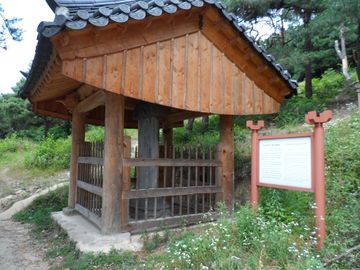"화산서원비"의 두 판 사이의 차이
(→영문) |
(→영문) |
||
| 38번째 줄: | 38번째 줄: | ||
This stele records the history of Hwasanseowon Confucian Academy which once was located here. The stele was erected to commemorate the occasion of the king personally naming the academy and bestowing its name plaque. The text inscribed on the stele was composed in 1664 by Song Si-yeol (1607-1689) and calligraphed by Song Jun-gil (1606-1672), both prominent scholars and politicians of that time. | This stele records the history of Hwasanseowon Confucian Academy which once was located here. The stele was erected to commemorate the occasion of the king personally naming the academy and bestowing its name plaque. The text inscribed on the stele was composed in 1664 by Song Si-yeol (1607-1689) and calligraphed by Song Jun-gil (1606-1672), both prominent scholars and politicians of that time. | ||
| − | Confucian academies, called seowon in Korean, are private education institutions of the Joseon period (1392-1910) which usually combined the functions of a Confucian shrine and a lecture hall. Hwasanseowon Confucian Academy was founded in 1578 to honor Yi Eon-jeok (1491-1553) and Song In-su (1499-1547), two prominent scholars of the Joseon period (1392-1910). In recognition of its importance, in 1658, King Hyojong (r. 1649-1659) bestowed a name and granted land and manpower to the academy. However, in 1869, the academy was demolished when most shrines and Confucian academies were shut down by a nationwide decree. It was eventually rebuilt in 1994 at a new location in Wanju-gun County with only this stele left behind. | + | Confucian academies, called seowon in Korean, are private education institutions of the Joseon period (1392-1910) which usually combined the functions of a Confucian shrine and a lecture hall. Hwasanseowon Confucian Academy was founded in 1578 to honor Yi Eon-jeok (1491-1553) and Song In-su (1499-1547), two prominent scholars of the Joseon period (1392-1910). In recognition of its importance, in 1658, King Hyojong (r. 1649-1659) bestowed a name and granted land and manpower* to the academy. However, in 1869, the academy was demolished when most shrines and Confucian academies were shut down by a nationwide decree. It was eventually rebuilt in 1994 at a new location in Wanju-gun County with only this stele left behind. |
2020년 6월 3일 (수) 03:14 판
| 화산서원비 |
|
 화산서원비, 국가문화유산포털, 문화재청. |
|
| 대표명칭 | 화산서원비 |
|---|---|
| 한자 | 華山書院碑 |
| 주소 | 전라북도 전주시 완산구 중화산동 산33-2번지 |
| 지정번호 | 전라북도 문화재자료 제4호 |
| 지정일 | 1984년 4월 1일 |
| 분류 | 기록유산/서각류/금석각류/비 |
| 수량/면적 | 1기 |
| 웹사이트 | 화산서원비, 국가문화유산포털, 문화재청. |
|
|
|
해설문
국문
서원은 선현(先賢)에게 제사를 지내고, 유학을 가르치던 사립 교육기관이다. 화산서원은 선조 11년(1578)에 전주부윤*으로 도덕과 예절로 백성들을 가르치는데 힘쓴 이언적과, 전라감사**로서 청렴한 정치를 펼친 송인수의 행적을 기리고 제사를 지내기 위해 세워졌다. 효종 9년(1658)에는 서원의 가치를 인정해 왕이 서원의 이름을 지어주고 노비, 서책, 토지 등과 함께 현판(액자)을 내려주는 사액서원이 되었다.
화산서원비는 사액서원이 된 것을 기념하여, 현종 5년(1664)에 조선시대 대학자인 송시열(宋時烈)이 글을 짓고, 송준길(宋浚吉)이 글씨를 썼다. 고종 6년(1869)에 서원철폐령에 따라 건물이 헐리고, 현재는 화산서원의 역사를 기록한 비만 남아 있다.
화산서원은 1994년에 완주군 소양면 신원리로 옮겨 복원되었다.
- 부윤(府尹): 조선 시대의 지방 관아인 부(府)의 우두머리
- 감사(監司): 조선시대 각 도에 파견된 지방 행정의 최고 책임자
영문
Stele of Hwasanseowon Confucian Academy
This stele records the history of Hwasanseowon Confucian Academy which once was located here. The stele was erected to commemorate the occasion of the king personally naming the academy and bestowing its name plaque. The text inscribed on the stele was composed in 1664 by Song Si-yeol (1607-1689) and calligraphed by Song Jun-gil (1606-1672), both prominent scholars and politicians of that time.
Confucian academies, called seowon in Korean, are private education institutions of the Joseon period (1392-1910) which usually combined the functions of a Confucian shrine and a lecture hall. Hwasanseowon Confucian Academy was founded in 1578 to honor Yi Eon-jeok (1491-1553) and Song In-su (1499-1547), two prominent scholars of the Joseon period (1392-1910). In recognition of its importance, in 1658, King Hyojong (r. 1649-1659) bestowed a name and granted land and manpower* to the academy. However, in 1869, the academy was demolished when most shrines and Confucian academies were shut down by a nationwide decree. It was eventually rebuilt in 1994 at a new location in Wanju-gun County with only this stele left behind.
- 노비: is it 勞費 or 奴婢?
영문 해설 내용
이 비석은 이곳에 있던 화산서원의 역사를 기록하고, 사액된 것을 기념하기 위해 세운 것이다. 비문은 1664년에 조선시대의 학자인 송시열(1607-1689)이 짓고 글씨는 송준길(1606-1672)이 썼다.
서원은 조선시대에 설립된 사설교육기관으로, 선현 제향과 교육의 기능을 수행하였다. 화산서원은 조선시대의 학자 이언적(1491-1553)과 송인수(1499-1547)를 기리기 위해 1578년에 창건되었다. 1658년에는 이 서원의 가치를 인정하여 효종(재위 1649-1659)이 이름을 지어주고, 노비, 서책, 토지 등을 하사하였다. 그러나 화산서원은 서원철폐령에 따라 1869년에 철거되었고, 1994년 완주군에 다시 세워지면서 이곳에는 비석만 남게 되었다.